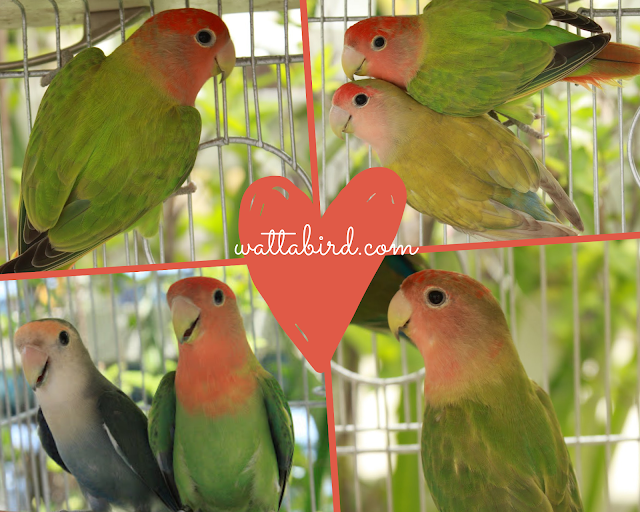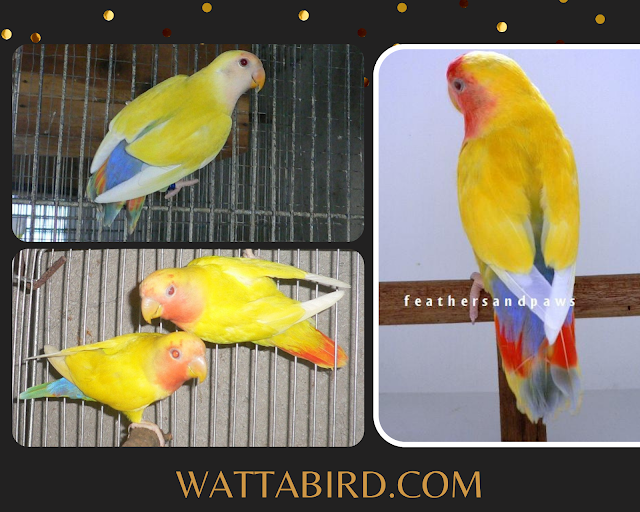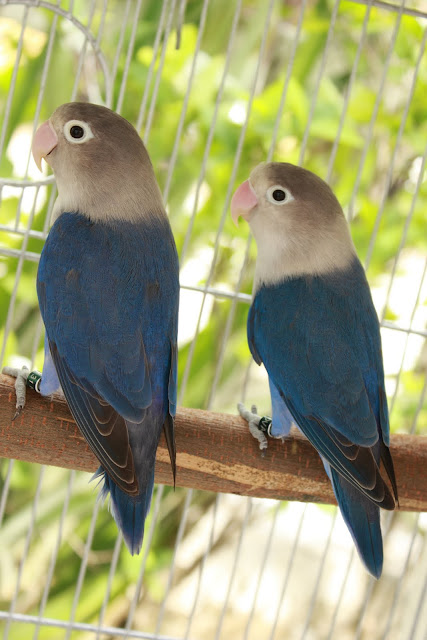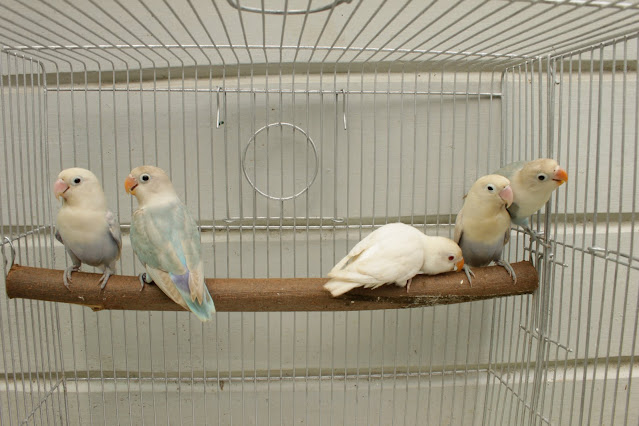WattaBird! Breeding White African LoveBirds
White LoveBird
This project is aimed at producing White LoveBirds. In technical terms, these are called Turquoise Ino or Blue Violet Ino mutations.
I got this breeding program from Tom's LoveBird Farm in Riverside California.
I requested from Tom, permission for me to use the information related to his breeding projects, which he willingly gave his approval and I'm very much thankful for his generosity.
The projected offspring for this project is a LoveBird (Agapornis Roseicollis), which is almost all white with a yellow tint on the wings and head.
The rump also will have barely yellow on it. For the rest of this article, I will be addressing this as a White LoveBird.
I'm very much excited about this breeding project, and looking forward to my first White LoveBirds!
OPTION 1:
First Generation Pairing: Creamino (Cock) x Blue Violet (Hen)
First Generation Projected Offspring:
- Daughters will be Creamino split to Turquoise Ino
- All black-eyed chicks will be Male that are split to Creamino and Turquoise Ino
From the above First Generation Offspring, take a Cock and use for the next pairing.
How White the Offspring will really be, will depend on color of the face of the parents. The more white the faces are, the more white the offspring will be.
OPTION 2:
First Generation Pairing: Blue Violet (Cock) x Creamino (Hen)
First Generation Projected Offspring:
- All Male Offspring will be split to Turquoise Ino
From the above First Generation Offspring, take a Cock and use for the next pairing.
How White the Offspring will really be, will depend on color of the Head of the parents. The more white the heads are, the more white the offspring will be.
STATUS:
Still sourcing for the Blue Violet LoveBird Cock.
A Creamino Hen LoveBird is already available and being conditioned for this breeding project.
I initially thought I got the Cock, but apparently, upon consultation with Tom, I actually got a Cobalt and not the required Blue Violet LoveBird.
*****************************
Breeding White LoveBirds Gallery
This is the projected offspring, a White LoveBird.
Photo courtesy of Tom's LoveBird Farm in RiverSide California.
Here's another photo of a White LoveBird.
This is also known as the Turquoise Ino LoveBird.
Photo courtesy of Tom's LoveBird Farm in RiverSide California.
Here's my Creamino Hen LoveBird in waiting.
She is currently being conditioned for this project.
*****************************
Found out that the cock I got was
not a Blue Violet LoveBird, but a Cobalt!
Wrong Mutation!
This is not a Blue Violet LoveBird, but rather a Cobalt!
It is important to get the correct pairing mutations,
otherwise, the offspring will be different and will not be as what is expected.
Now back to sourcing for the Cock!
*****************************
Please come back for the updates on this project.
"The main objective of wattabird.com is to promote African LoveBirds Breeding as a hobby, share breeding experiences, tips, techniques, best practices, and most importantly, to promote camaraderie among LoveBirds Breeders." - WattaBird.com














I have been breeding white (snow white) lovebirds for the last 3 years. It started by accident and i now have 6 pairs. They mix and match with yellow or green mates.
ReplyDeleteMuriel. Cape Town. South Africa.
Hey thanks a lot for the info i am a beginner
ReplyDeleteafter First Generation Offsprings, take a Cock and use for the next pairing. next pairing with which bird
ReplyDelete@muriel germishuys plse help
ReplyDeleteIf i have a turquoise Ino bird? what should i pair it with to get turquoise ino offsprings?
ReplyDeleteHow to produce a df violet peach using green violet bird
ReplyDeleteVery Interesting...I was gifted a Creamino, Opaline (cobalt), Lutino (rd eyed) male. The only way to know--of course, whether Male or Female is to get a genetic test. However, we are 90% sure it is a male, as my husband is the Chief Ornithologist in the UK, and after observing our Magnus's behavior.) He has been banded...at birth, as it is a solid band--also the band itself is 'luminescent', looks like the ring was sprayed in opal, and of course..it is in Asian, just like his previous owner was when she absolutely had to give him up, as she needed to return to Asia for an emergency, and she had to find him a home.
ReplyDeleteWhen we discovered how rare he was, especially the fact that we found pictures that looked like him were far and few, and especially being a Lutino as well..we found limited info on him.
If anyone can tell me more--especially this project--I would be very interested in our little spitfire Magnus. Again, his feathers are white, and pale yellow. He has a tuft of 'ginger' feathers on his vents, and interesting cheeks coming in. I was told he was just over a year old, and we have had him for 6 months now.Any input would be appreciated.(I will be following this blog to see...
Cheers! Sadie Rae
This comment has been removed by the author.
ReplyDeleteVery Interesting...I was gifted a Creamino, Opaline (cobalt), Lutino (rd eyed) male. The only way to know--of course, whether Male or Female is to get a genetic test. However, we are 90% sure it is a male, as my husband is the Chief Ornithologist in the UK, and after observing our Magnus's behavior.) He has been banded...at birth, as it is a solid band--also the band itself is 'luminescent', looks like the ring was sprayed in opal, and of course..it is in Asian, just like his previous owner was when she absolutely had to give him up, as she needed to return to Asia for an emergency, and she had to find him a home.
ReplyDeleteWhen we discovered how rare he was, especially the fact that we found pictures that looked like him were far and few, and especially being a Lutino as well..we found limited info on him.
If anyone can tell me more--especially this project--I would be very interested in our little spitfire Magnus. Again, his feathers are white, and pale yellow. He has a tuft of 'ginger' feathers on his vents, and interesting cheeks coming in. I was told he was just over a year old, and we have had him for 6 months now.Any input would be appreciated.(I will be following this blog to see...
Cheers! Sadie Rae